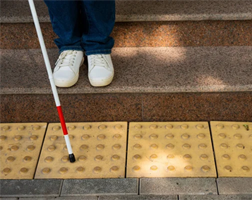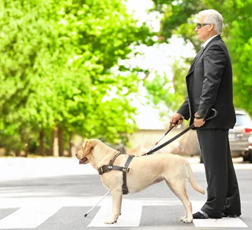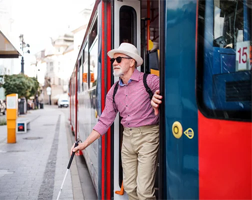Most people who are blind or who have substantially diminished vision use a white cane when walking. The cane allows them to find obstacles in their paths, recognize uneven pavements or terrains, and handle steps and curbs. It also alerts others to the user’s visual impairment, allowing them to offer assistance or stay out of the way.

Traditionally, the preferred length of the cane has been up to collar bone level, but recently the use of longer canes rising to chin level has been promoted. Those who favor the longer cane believe it allows the user more time to react to upcoming steps, curbs and obstacles while those who support the shorter cane find it functions better to guide over and around the area immediately in front of its user and avoid entanglement with other nearby people. The cane may be rigid or collapsible, either by folding into sections or telescoping one-half into the other. Collapsible canes are usually lighter and more convenient to carry when not in use but they are not as strong or durable as rigid ones. Both rigid and collapsible canes can be purchased at local low vision product stores or from online vendors. See the link Commercial Aids on this site for contact information for vendors. Rigid white canes can be obtained for free from the National Federation of the Blind (NFB).
Roughly 3% of blind people choose to use a guide dog. Numerous organizations provide guide dogs and training in their use, often for free. The American Foundation for the Blind (AFB) provides information about such organizations. See the link Resources on this site for information about AFB. Information about its directory of guide dog organizations can be found at the following page on AFB’s web site:
http://www.afb.org/

For information about accommodations that must be made available for guide dogs under the Americans with Disabilities Act, visit the web site at:
http://www.ada.gov/regs2010/service_animal_qa.html.
A new robotic device that uses AI is being developed that would be used in place of a white cane or guide dog. Called the Glide, it consists of a body similar to the cane perched upon two wheels with cameras that can guide you around persons and obstacles and lead you on programmed routes or let you travel freely as you choose. Orders are being accepted now for delivery in the fall of 2025. For more information, visit the web site at:
Adults may receive free orientation and mobility training through their home governmental rehabilitation divisions. See the link Resources on this site for information about these divisions.
Most jurisdictions provide a low cost shared ride paratransit service for blind and low vision persons. This may be offered within a state, county or geographic area and typically rides must be made within a short distance from where public transportation such as subway trains or buses run. Rides usually must be booked at least one day in advance. Riders are given a half hour pick up window and may be dropped off substantially before or after their desired arrival time.

The Federal Department of Transportation provides information about the transportation rights and options of people with disabilities. Information is available concerning air and train travel as well as local trips. Information can be found by visiting the web site at:
https://www.disability.gov/resource/disability-govs-guide-transportation/
Both Uber and Lyft offer rides by private drivers that are booked on smart phone apps. The cost is shown before the trip is booked. The driver can generally be reached by text or call once the trip is booked. Drivers are required to allow guide dogs in their cars. If you do not have a smart phone or want to use an app, you can request a ride by phone for an additional fee by calling Go Go Grandparent at (855) 464-6872 or (855) GOGO USA. In Arizona, California and Florida you can book Uber directly by phone, avoiding the additional fee, by calling (833) 873-8237.
